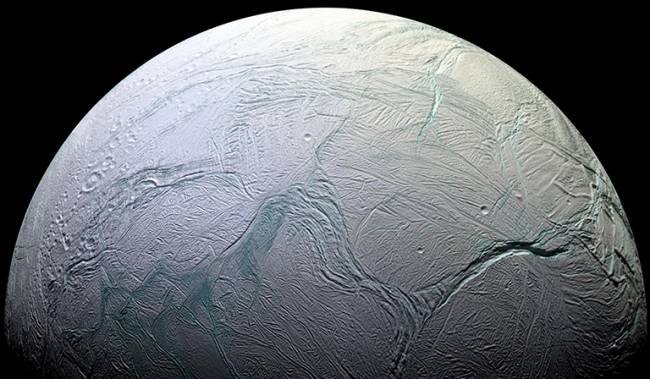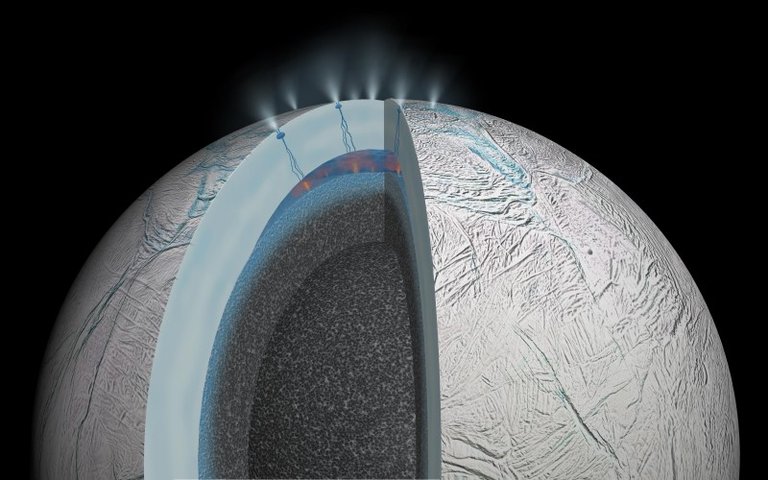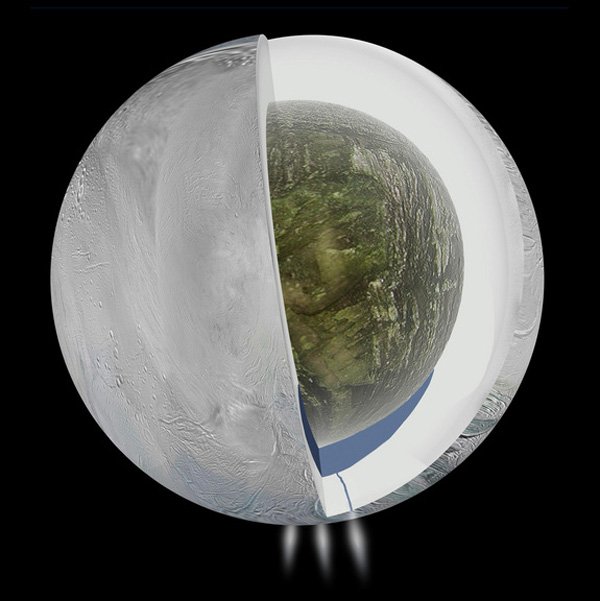The subscular ocean of Enceladus can remain liquid due to friction arising in the porous satellite core due to the impact of Saturn's tidal forces. During this process, heat can be released, which is enough to prevent water from freezing, and the ice layer in the poles area was thin. This can explain how the geysers managed to break through the icy crust of the celestial body.

The researchers suspected that the ocean could be hidden under the surface of Enceladus, when "Cassini" in 2005 transmitted to the Earth pictures of geysers hitting the "tiger stripes" of the satellite. Subsequent measurements of the gravitational field of the moon allowed us to confirm this hypothesis. Based on these data, the researchers calculated the mass distribution of the satellite: it was found that the radius of the Enceladus nucleus is 190 kilometers, the thickness of the mantle is 60 kilometers. In addition, astronomers have discovered a large gravitational anomaly in the region of the South Pole - just where geysers are beating. Its existence was best explained by the presence of a liquid subsurface ocean.

Planetologists have long been trying to explain how the ocean of Enceladus can remain liquid at such a distance from the Sun. One hypothesis suggests that the tidal forces of Saturn lead to deformation of the satellite's surface. Between the dry edges of the ice slabs friction occurs, resulting in heat being released, but not enough to keep the ocean liquid for many millions of years. If the only source of energy was tidal friction in the ice crust, the water in the bowels of Enceladus would freeze in less than 30 million years. Therefore, the authors of the new work suggested that there must be another mechanism that ensures the influx of heat. According to scientists, they can have tidal friction in the satellite's core.
Researchers assessed the density of the nucleus of Enceladus and concluded that it should consist of porous rocks - probably iron-containing hydrated minerals. In the holes, occupying about 20-30 percent of the core volume, oceanic water enters. "When we talk about a porous core, we do not mean a sponge, it's rather a pile of sand or gravel," comments Gael Schoble, one of the authors of the work.
The action of the tidal forces of Enceladus leads to friction between the fragments of the nucleus. Simulations show that as a result, up to 10 gigawatts of heat can be released. Oceanic water circulates through the holes, heats up and forms upflows with a temperature of up to 90 degrees Celsius. They rise from the so-called "hot spots", narrow areas of the surface of the nucleus, with a significant proportion of them located in the region of the southern pole of the satellite. This may explain why the ice cortex in this region is noticeably thinner than in all other parts of Enceladus - its thickness is only 2 km, while the thickness of the surface in other places is estimated at 18-22 km.

The friction of the ice plates of the surface and the radioactive decay in the core can serve as additional sources of heat. This makes the conditions on the satellite potentially suitable for the birth and maintenance of life.
Astronomers and planetologists have repeatedly said that the hidden ocean of Enceladus can potentially be suitable for life. In addition to water, carbon dioxide methane and ammonia, scientists found in it large amounts of hydrogen, which indicates active hydrothermal processes. Also, the data of Cassini, which recently completed its mission, show that the satellite's ocean is an alkaline medium, more likely resembling ammonia solutions.

Nice scientific post , Mostly related to space. Most the information are above the level of my understanding :)
Wow great article about one of the most if not THE most interesting object in our Solar system because it contains huge amount of fluid water 🌊🌊
I would love to see a mission to Enceladus with a lander and a robot which could melt down to those extraterrestrial Oceans deep beneath the thick ice layer. 🚀😁
img credz: pixabay.com
Nice, you got a 51.0% @goldsteem upgoat, thanks to @kuku12170
It consists of $0.31 vote and $0.1 curation
Want a boost? Minnowbooster's got your back!
The @OriginalWorks bot has determined this post by @kuku12170 to be original material and upvoted(1.5%) it!
To call @OriginalWorks, simply reply to any post with @originalworks or !originalworks in your message!